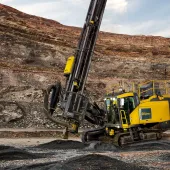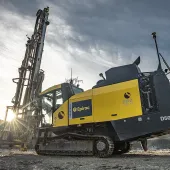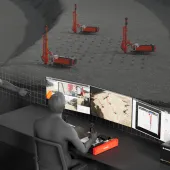Drilling Process Optimization

The impact of correct drill rig selection on downstream processes
Quarrying as a process comprises a number of consecutive sub-processes — drilling, blasting, secondary breaking, loading, hauling, crushing, screening, stockpiling and delivery of saleable products. Each quarry is unique and needs to be planned carefully in terms of both working practices and the selection of equipment in order to maximize the profitability of the operation.
Excavation process approach
The selection of drilling equipment and drilling tools has a significant impact on the subsequent processing stages, such as explosives consumption (powder factor), rock fragmentation, the amount of oversize boulders and the need for secondary breaking, the formation of toes and floor humps and their affect on rock loadability, loading and hauling capacities, and the design of crushing plants.
Quality aspect
Today, increased attention is directed towards end-product quality such as cubicity and a minimized amount of micro-cracks in the aggregates.
QUARRY PROCESS
Aggregate production costs
A typical cost distribution for operations in granitic rocks is presented in figure 5.
Drilling cost
Drilling represents 11–17% and blasting 10–20% of the total cost per tonne of aggregates produced. Owing to technical and economical consequences in the following stages of the excavation process, thorough attention must be paid to the proper selection of drilling equipment in terms of hole size, hole length, performance, hole quality and ergonomics.
EQUIPMENT SELECTION
Hardware
There are different requirements relating to drilling equipment, drilling tools and drilling applications depending on the type of bench blasting operation. In open-pit mining and quarrying, the emphasis is normally on long-term performance and hole quality, whereas a general contractor or drilling contractor operating in a variety of conditions is likely to pay more attention to the flexibility and terrain-handling features of the equipment. But for all equipment users, economy, reliability, ergonomics and ease of use are of vital importance.
In planning the blasting pattern, careful consideration must be given to the type and size of loading equipment. In wheel loader operations the rock pile should preferably be long and shallow with blasting planned to produce a loose pile. Front-shovel characteristics on the other hand are best supported by higher, peaked rock piles. This can be achieved with a V-type initiation pattern.
Services and support
Today, customers expect equipment suppliers to have an understanding of their total excavation process. In addition to hardware and equipment features, manufacturers’ ability to provide related services, such as equipment performance estimates (to ensure optimal equipment selection), cost estimates, application recommendations, start-up help and training, as well as maintenance and parts services, is greatly increasing their role in today’s market place.
Software
The best simulation programs provide practical and proven tools for excavation process planning. For example, with the Tamrock’s surface drilling simulation software, ‘Surface Study Program’, it is possible to perform multiple tasks including: hole size, drilling equipment and drilling tools selection; drilling capacity estimates; calculation of drill patterns, powder factors and specific drilling vs rock fragmentation curves; estimates of oversize boulder percentage with respect to primary crusher size, production estimates and drilling and blasting costs.
Accurate drilling
Accurate drilling is a combination of minimized in-hole deflection and careful alignment of the drill feed as per pre-planned blast patterns. Minimized in-hole deflection is achieved with an optimum drill bit/drill string combination and the proper adjustment of drilling parameters. Depending on the rock conditions and target accuracy, various types of drill bits are available on the market today.
Modern alignment instruments are easy to use and, as well as basic tasks such as hole inclination and azimuth, additional features such as automatic drill stop at the required depth are also available. Depth can be referenced to either the rock surface or a laser level. Furthermore, it is possible to expand the capability of the alignment instrumentation with the ability to collect drilling and work data.
CONCLUSIONS
Drilling and blasting costs increase with increasing rock fragmentation requirements. If considered in isolation, the most economic drilling and blasting operations are achieved with extremely coarse fragmentation. However, when the downstream operational costs are taken into account, such as secondary breaking and loading, the picture is quite different. Moreover, drilling costs drop and blasting costs increase with increasing hole diameter. However, the total drilling and blasting cost per tonne or per cubic metre of excavated rock decreases with increasing hole diameter.
It is important to note that although overall in-pit quarrying costs decrease with increasing hole diameter, the amount of fines and micro-cracks in the blasted rock fragments, as well as the number of oversize boulders, rises with increasing hole diameter.
Whether the presence of excessive fines and/or micro-cracks is harmful or not depends entirely on the end use of the blasted material. As suppliers to the construction industry, aggregate producers generally aim to minimize the amount of micro-cracks in aggregate and deliver cubicity as per contract specifications. Blasted fines are often removed from the crushing process and considered as waste. On the other hand, a cement producer may find fines and micro-cracks useful at the crushing and milling stages of the process.
Drill rig selection is an important component in the planning of the rock excavation process. Modern drilling units with powerful rock drills, suitable drilling tools and sophisticated instrumentation meet the demands of hole quality and productivity and form a part of the total process of optimization.
REFERENCES
LISLERUD, A: ‘Fjellsprengningsteknikk’, Norges Tekniske Høgskole, Trondheim, p229, 1990.
Sandvik Tamrock: ‘Quarry Academy’, Tampere, 1999.








